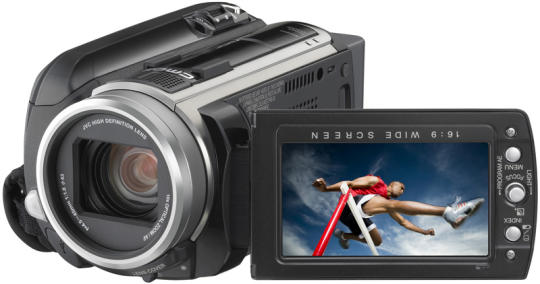
Pros: Impressive picture quality, 1080p Full HD resolution, 120GB HDD,small form factor, good color in low light
Cons: Noise in low light. Pricey.
The JVC GZ-HD40U is small enough to go anywhere and can produce some very high-quality recordings. It’s about as long as a soda can and somewhat fatter. It weighs a bit over a pound and is comfortable to hold for hand held shooting. While the entire body is plastic, it feels well made and solid. There are very few controls on the camera, making its operation quite simple and straightforward. The image quality in well lit environments is stunning. Overall, I’ve really enjoyed using this camcorder.
With good lighting, sunlight or very bright indoor lighting, the image clarity is superb. As the amount of light decreases, the HD40U produces fairly accurate colors without having to go into a sub-menu and adjust the exposure (AE). No orange faces in dim, indoor places. This is a huge differentiator, for me,compared to lower-end cameras that don’t automatically handle colors well in a variety of light situations. Unfortunately, you will also loose crispness and add noise as the amount of light decreases. This has nothing to do with the AE,but just the lack of light. The more stable the camera (i.e. tripod), the less of an effect this will have, but it will still be noticeable. There is a built-in LED light to help with low-light shooting, but it is only good for about 5′-10′. Even in extremely dark rooms, early morning with shades drawn, the HD40 still picked up plenty of details and recorded impressive footage for that light situation.

Small (771×649) excerpt from a full frame (1920×1080) shot using AVCHD in daylight. Actual size. The jaggies are because this is a motion shot. I am holding the camera facing both of us as we walk around the house. Click for larger image.
The HD40U powers on automatically and quickly when the screen is opened. No extended boot time. As I mentioned, the controls are very simple. To the left of the screen are a small, clickable joystick and two function buttons. The joystick makes it easy to navigate menus and recordings and allows for quick access to the attached LED light and manual exposure (AE) settings while recording. One of the buttons accesses the menu in either playback or record mode. The other button displays the index of recordings while in playback mode and toggles between remaining recording time/HDD space available and a detailed battery display during record mode. These displays are simple yet informative. The remaining recording time shows the HDD use as a pie chart and how much time is remaining with each compression setting. You can also change the compression setting from this view. The detailed battery display shows the status in 10%increments as well as the maximum number of minutes remaining. These two screens are invaluable and easily accessible. The other primary controls, record, zoom,and take a snapshot, are in operated by the right hand and are placed exactly where you have come to expect them.
The HD40U supports the AVCHD and MPEG-2 recording formats. AVCHD will provide better compression, longer record times, and direct burning to DVD, while the MPEG-2 will allow for higher picture quality and easier compatibility with existing editors. You won’t be worrying about running out of space with the 120GB HDD even though at the high quality AVCHD setting you’ll have an average bit rate of 17 mbps and with MPEG-2, a whopping 26.6 mbps. This may be one of the biggest changes for people accustomed to removable media camcorders that used tapes or discs. There’s no more media to buy, ever. No tapes to change while recording and then lose later. All the footage is recorded onto the massive 120GB internal hard drive, which can hold between 10 and 50 hours of footage, depending on your compression settings. You transfer all the footage as individual clips to your PC where you can easily edit, store and share them. I know it sounds like it’s going to take up a lot of space, but with terabyte drives (1000GB) priced at ~$120 and falling, storage space will be the least of your concerns.
Before I downloaded the video, I wanted to see how it would look streaming to my 32″ 1080i WinBook LCD TV. The HD40U comes with a mini-component cable and an AV cable for standard definition TVs. There is also an HDMI port on the camera, but the HDMI cable is not included. Blowing up the image to this size makes some of the visual noise more apparent, but I’m sure I’ll also have commenters saying that if I’d used HDMI instead of the included component connector, it may have reduced some of the visual noise. Both the camcorder and the included dock have HDMI, component, and AV outputs for video streaming, as well as power, and USB. The dock also has an additional Firewire port that the camcorder does not. Keep the dock connected to your PC for easy file downloads or keep it hooked up to your home theater to quickly share the footage you’ve shot.
Stepping more towards the pro, the HD40U allows for additional accessories to be used that lower end models do not. There is an input for an external mic as well as a headphone jack to listen to recordings or to monitor the sound being recorded. It also includes an accessory shoe that allows you to mount a light or an external mic. While most consumers won’t need these kinds of accessories,it’s nice to have the option of adding a higher quality mic, a wireless mic, or an LED light bank for better quality in low light environments.
Unfortunately, the JVC software is not Mac compatible. No worries. The camcorder easily connects with iMovie, although the conversion from AVCHD to Quicktime’s .mov will take some time. Even though the camera records at 1920×1080, you have a choice to make when downloading. An hour of full HD video takes up about 40GB of space on your drive in Quicktime’s format. Additionally, some hard drives may not be fast enough to serve the information at adequate speeds for smooth playback. However, if you download it at half resolution, an hour is only 13GB.I had no problems playing the video back at full size on my Macbook Pro. Well, Idid have one problem. Full HD video is bigger than the screen resolution of the 15″ laptop, so I was viewing it at half resolution anyhow. Comparing it to footage I downloaded at half resolution, I couldn’t tell the difference. So whether you really need to save full HD files depends on what you intend to do with them.
At the same time I was evaluating the HD40U, I was also evaluating the MG330. It’s a lower end consumer level camera that has a smaller form factor and is not HD. It’s a great camera, but I definitely gravitated towards the HD40U. While the higher resolution was a factor, the main differentiator to me was that I knew that when I turned on the HD40U and started shooting, the color would be more true to life than the MG330. It may seem like a small issue when comparing camcorders that are hundreds of dollars apart in price, but often I am trying to capture something fleeting that is happening now. I don’t have time to set things up before I start recording. That’s worth the extra money. The HD40U has an MSRP of $1299, but can be found for about 2/3 of that price.
Bottom Line: Prosumer camcorder with high resolution, lots of storage,options for output and extras.